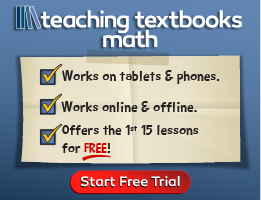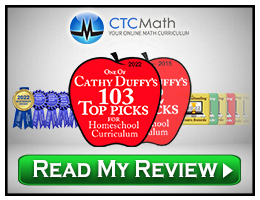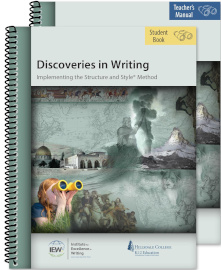Implement IEW's Structure and Style® methodology with three, year-long courses for grades four through six, Discoveries in Writing, Frontiers in Writing, and Investigations in Writing—all subtitled Implementing the Structure and Style® Method. While the courses are suggested for particular grade levels and gradually increase the level of difficulty, they might be used with younger and older students.
To teach these courses, a parent or teacher must be familiar with IEW’s Teaching Writing: Structure and Style (TWSS), the underlying methodology. Each course implements the methodology step by step. However, students new to TWSS can begin with any of these courses.
In theory, parents and teachers can learn the TWSS methodology and come up with their own source texts and assignments to help students gradually build skills for independent writing using proper structures and stylistic enhancements. However, using IEW’s published resources makes much more sense in most situations. Most of IEW’s implementation resources, aside from those in their Structure and Style for Students series, use source text passages drawn from a single academic discipline, as in their series of History-Based Writing Lessons. In this case, Discoveries, Frontiers, and Investigations use a broader range of source texts, drawing from history, geography, science, fables, mythology, and fiction. For example, Frontiers in Writing has students work with articles about topics such as the Great Lakes, Halley’s Comet, Nicholas Copernicus, the fable of “The Lion and the Mouse,” the Mona Lisa, and recycling.
All three courses follow the same sequence through the first seven units:
- Note Making and Outlines
- Writing from Notes
- Retelling Narrative Stories
- Summarizing a Reference
- Writing from Pictures
- Summarizing Multiple References
- Inventive Writing
Discoveries in Writing for fourth graders stops at that point, while Frontiers and Investigations both add two more units:
- Formal Essay Models
- Formal Critique
Each course has a student book and a teacher’s manual--both spiral-bound and printed in black and white. The teacher’s manuals have reduced images of the student pages, with predictable answers overprinted when applicable. Lesson pages with images of student pages are surrounded by instructional information. Lesson pages are followed by several appendices that include suggested literature titles, a few pages on grammar mechanics, a chart for teaching vocabulary words, six vocabulary quizzes, and several review games. (Most games are for groups.) In addition, a blue page near the front of each book has instructions for accessing extra online resources for vocabulary cards, checklists, and exemplars.
Student books provide daily assignments and schedules for students, allowing those already familiar with TWSS to work independently much of the time, while those new to TWSS will need more assistance. Students have space in their books for writing many answers and assignments, but their compositions will be done outside the books. All students need an “editor” to go over their work and provide feedback.
While developing composition skills is the primary focus, vocabulary work is an important part of each course as students learn to “dress up” their writing with interesting words. Students also practice public speaking as they share their final pieces orally.
Summary
The Teaching Writing: Structure and Style methodology has proven successful for thousands of students over many years, and it's great to have even more resources for implementing the methodology.















